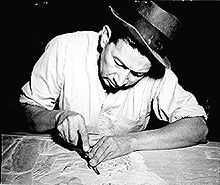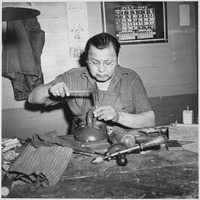Jesse Cornplanter
| Jesse Cornplanter | |
|---|---|
|
Jesse Cornplanter making a ceremonial mask, Tonawanda Community House, Tonawanda, New York. Photographed in 1940. | |
| Born |
Hayonhwonhish September 16, 1889 Cattaraugus Reservation, NY United States |
| Died | 1957 |
| Occupation | Author, artist, craftsman |
| Ethnicity | Iroquois |
| Citizenship | American citizen 1924 |
| Subject | Seneca life, culture, and religion |
| Literary movement | Iroquois Realism |
| Notable works | Legends of the Longhouse, Iroquois Indian Games and Dances, collection SC12845 at the New York State Library, illustrated The Code of Handsome Lake |
| Relatives | Father Edward Cornplanter (Seneca name Sosondowah) |
Jesse J. Cornplanter (September 16, 1889 – 1957) was a Seneca artist and author. His Seneca name was Hayonhwonhish. As an author he wrote Legends of the Longhouse,[1] which records many Iroquois traditional stories.
Personal
Jesse Cornplanter was born in 1889 on the Cattaraugus Reservation in New York, and was the last direct descendent of Cornplanter, the Seneca war chief during the American Revolutionary War.[2]
During World War I, Cornplanter enlisted in the US Army in 1917 and served in Europe. He was wounded during the war and received the Purple Heart.[3] While at war, most of his remaining family died in the 1918 flu pandemic.[4]
Within his tribe, Cornplanter held many respected positions, including the ceremonial chief of the Long House and the chief of New Town, a traditional village. He sang for the Great Feather Dancer and was head singer for many ceremonies.[2]
Because he left no heirs, his death officially marked the expiration of a treaty granting Cornplanter's heirs a perpetual Pennsylvania land grant along the Allegheny River; seven years later, much of the tract would be flooded as a result of the construction of the Kinzua Dam.[5]
Artwork

In 1901 the Seneca Director of the Rochester Museum, Arthur C. Parker commissioned Cornplanter to sketch scenes of contemporary Seneca life. This launched an eight-year collaboration between the two men.[6] Forty-five of these drawings are in collection SC12845 at the New York State Library.
Though only in his teens, Cornplanter was gaining recognition for his skillful portrayals of his tribe. He never received formal art training,[2] but that did not hinder his success. Frederick Starr commissioned Cornplanter to illustrate Iroquois Indian Games and Dances, a book depicting Iroquois life.[6] In addition, Jesse Cornplanter illustrated The Code of Handsome Lake, a book written by his father, Edward Cornplanter (Seneca name Sosondowah), and Arthur C. Parker. Cornplanter wrote and illustrated his own book, Legends of the Longhouse, published in 1938.[6]
His paintings are considered to be in the Iroquois Realist Style, following in a painting tradition dating back to the 1820s work by Tuscarora brothers, David and Dennis Cusick.
Although best known for his illustrations, Cornplanter was also a traditional wood carver and greatly influenced successive generations of Haudenosaunee artists.[6]
Bibliography
- Cornplanter, Jesse J. (Of The Senecas), Told To Sah-Nee-Weh, Legends of the Longhouse. Philadelphia: J. B. Lippincott, 1938.
See also
Notes
- ↑ Native American Authors Project
- ↑ 2.0 2.1 2.2 Lester, Patrick D. The Biographical Directory of Native American Painters. Tulsa, OK: SIR Publications, 1995: 125
- ↑ Aul, Billie (August 1996). New York State Library "Cornplanter, Jesse: Drawings SC12845". New York State Library. Retrieved 2008-07-19.
- ↑ Bulletin of the New York State Museum, 1920. Section: “Death of Chief Edward Cornplanter,” pages 104 and 105.
- ↑ "Chief Cornplanter", Pennsylvania Historical and Museum Commission, retrieved February 3, 2011
- ↑ 6.0 6.1 6.2 6.3 Painting. The Iroquois Museum. (12 Feb 2009).
|
